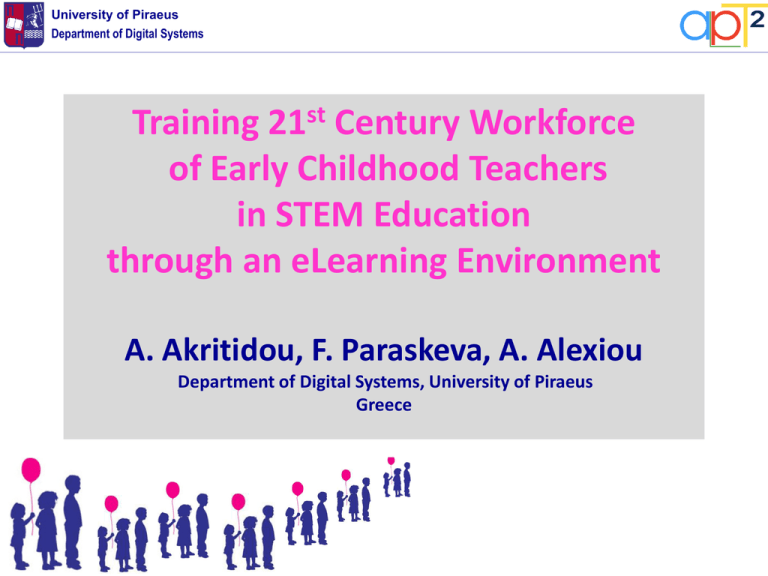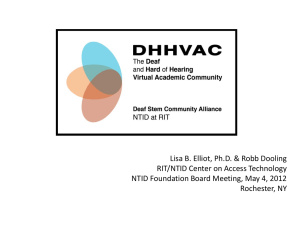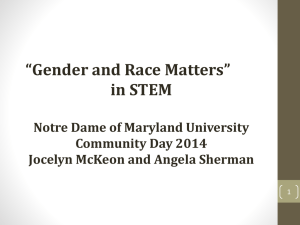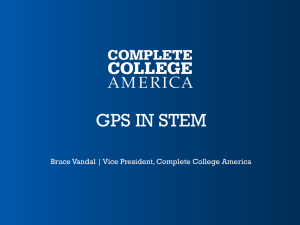Slides - ICELW
advertisement

University of Piraeus Department of Digital Systems Training 21st Century Workforce of Early Childhood Teachers in STEM Education through an eLearning Environment Α. Akritidou, F. Paraskeva, A. Alexiou Department of Digital Systems, University of Piraeus Greece University of Piraeus Department of Digital Systems Our University The Distance: Greece – New York The University of Piraeus was founded in 1938 under the title of the “School for Industrial Studies”, by the Industrialists and Tradesmen Association. In 1999 was established the Department of Digital Systems University of Piraeus ΨDepartment of Digital Systems Contents Research gap Introduction Literature Review Method Results Conclusions University of Piraeus Department of Digital Systems It is a compelling need for early childhood teachers to be trained to implement more challenging and technologyoriented methods at teaching including interdisciplinary approaches in learning. University of Piraeus Department of Digital Systems Continuing Professional Development (CPD) training programs. Τeachers should have access to effective Continuing Professional Development (CPD) training programs. CPD is a lifelong process or activity based on approaches, strategies and techniques that will contribute to an increase in skills and knowledge related to learning and teaching (HEA, 2009). University of Piraeus Department of Digital Systems The Idea: A CPD STEM training program An eLearning training program is proposed supporting teachers in exploring new ideas and enhancing skills related to Science, Technology, Engineering, and Mathematics (STEM Education). University of Piraeus Department of Digital Systems The General Aim : is the implementation of the STEM methodology (Science, Technology, Engineering and Mathematics) by the model of Cognitive Apprenticeship in an eLearning Environment enhancing collaboration among early childhood teachers. University of Piraeus Department of Digital Systems This CPD STEM training provides a structured pathway : • To develop • To specialize in knowledge and skills • To provide high quality programs and services to children. It is suggested that STEM education should begin at an early age when children's interests, desires and abilities are taking shape and while being natural explorers. University of Piraeus Department of Digital Systems As for early childhood teachers training in STEM education: will improve will offer benefits will expand their career opportunities. Students and teachers can work together in classroom activities that develop • • • • students' critical thinking communication evaluation research skills. University of Piraeus Department of Digital Systems But what is STEM??????? STEM education refers to teaching and learning in the disciplines of Science of Technology of Mechanics and Mathematics. If one breaks this term down, they can witness that much of this is already happening in early childhood programs (Ashbrook, 2010). www.enterrasolutions.com University of Piraeus Department of Digital Systems STEM and Preschool Education Science, technology, engineering and mathematics is already happening in preschool activities. Science may be planting seeds, mixing materials together to make an experiment, or touching objects with a magnet to control the attraction. Technology and computers would be tools. University of Piraeus Department of Digital Systems STEM and Preschool Education (Examples) In Mathematics students can measure and install the correct shapes. www.kindergartenkindergarten.com In Engineering children can daily plan and design structures with little teacher direction. lbdma.wordpress.com University of Piraeus Department of Digital Systems STEM and Preschool Education (The Need) Early exposure to STEM : supports children’s overall academic growth develops early critical thinking and reasoning skills, enhances later interest in STEM study and careers (Chesloff, 2012). Therefore, it is a compelling need to get more early preschool teachers educated in STEM. University of Piraeus Department of Digital Systems CPD STEM Training Program : Collaboration Collaborative learning is defined as a situation in which two or more people learn or attempt to learn something together’ (Dillenbourg,1999). Jigsaw is a strategy that provides students with an opportunity to actively help each other build comprehension. Students create learning groups. Early childhood teachers should be able to apply collaborative learning strategies and inquiry-based approaches (such as STEM methodology) in order to produce effective collaborative interactions among the learners (Battistich,& Watson, 2003). University of Piraeus Department of Digital Systems CPD STEM Training Program : Jigsaw Strategy Jigsaw Strategy Each group member is responsible for becoming an "expert" at one section. Advantages of jigsaw : the encouragement of attention participation of each team member in a substantial portion of an educational activity. Team members must work together as a team to achieve a common goal. Each student is dependent on others and no pupil can succeed if cooperation does not occur (Aroson & Patnoe, 1997). University of Piraeus Department of Digital Systems The Method This study is an action research. In this case, the action research used for the development of in-service early childhood teachers: improves teaching. develops new learning methods (STEM Methodology). enhances collaborative learning. University of Piraeus Department of Digital Systems Research Question The research question is: “Can the implementation of the STEM methodology (Science, Technology, Engineering and Mathematics) be supported by the model of Cognitive Apprenticeship in an eLearning Environment providing a means to enhance collaboration among early childhood teachers?” University of Piraeus Department of Digital Systems Participants The sample of the study consisted of 16 early childhood teachers 14 females and 2 males who participated voluntarily. Participants assigned to the Experimental Group (N=16) followed the process of implementing the eLearning Environment named: ‘apT²STEM’, in order to acquire new knowledge (STEM Methodology) and enhance collaborative learning. University of Piraeus Department of Digital Systems The eLearning environment ‘apT²STEM’ An autonomous electronic environment named ‘apT²STEM’, was designed following the principles of Cognitive Apprenticeship as a constructivist learning model, combined with the Jigsaw cooperative strategy. The eLearning environment named ‘apT²STEM’, is built up in Google Sites web application. Google Sites offered by Google as part of the Google Apps productivity suite and is a simple and intuitive tool for creating collaboratively personal and business web sites. superbwebsitebuilders.com University of Piraeus Department of Digital Systems The eLearning environment ‘apT²STEM’ University of Piraeus Department of Digital Systems Cognitive Apprenticeship Model Strategy Jigsaw Phase1 Activities Roles Teacher Oriented Phase 1.1 Presentation of STEM 1.2 BrainstormingQuestions on STEM Modeling Coaching Jigsaw 1:Group Composition Jigsaw 2: Composition of Expert Groups apT2STEM Communication tool Synchronous Collaboration tool Individual 1.3 Videos for STEM Phase 2 Learning Environment Individual Scaffolding Exploration Phase 3 Intermediate Phase Individual 2.1 Creation of 4 Groups 2.2 Synchronous Discussion Jigsaw 3: Discussion on Expert Groups 2.3 Experts study on Groups Jigsaw 4: Studying on Groups 2.4 Groups studying examples Jigsaw 5: Experts teach their Groups 2.5 Discussion Group Group Group Science Technology Engineering Mathematics Science Technology Engineering Mathematics Experts Science Technology Engineering Mathematics Student Oriented Phase Articulation Reflection 3.1 Implementation of STEM Methodology in Action 3.2 Discussion between learners and tutor Group Science Technology Engineering Mathematics University of Piraeus Department of Digital Systems Research variables The research variables for the eLearning environment ‘apT²STEM’, that have been studied were collaboration skills. Collaboration skills are measured by the assessment rubric R2-COLL. This rubric contains (7) modules with (7) questions, which are: M1: Participation through a modern communication tool with discussion and chat features M2: Identification of team roles M3: Respect M4: Behavior and obedience to rules M5: Leadership M6: Consequence M7: Participation in scenario morecoding.wordpress.com University of Piraeus Department of Digital Systems Results asifpremji.com For the statistical analysis of the results the statistical package SPSS (Statistical Package for the Social Sciences was used. To assess the internal consistency of the rubric the coefficient Cronbach alpha, where the index value is 0.843, confirming the reliability and internal consistency of this tool (rubric R2-COLL), was employed. In order to test the relations between the ordinal variables, we used Fishers exact test, since our data was not adequate to use Pearson’s x2-test of independence (the presumptions performing Pearson’s x2-test were not met: 1. no expected cell frequencies <1 and 2. no more than 20% of the expected cell frequencies < 5 (Apostolakis, M. A. Stamoulis, 2007) University of Piraeus Department of Digital Systems Results [1/2] Fisher’s Exact Test Kendall’s tau- M3 M4 M6 5,855a (16), p= 0,058 4,376a (16), p= 0,165 - - M7 M2 M5 M6 Note: aFisher’s b Exact Test. Kendall’s tau-b. c important test in α=0,05 8,959a (16), p=0,007 c 0,750b (16), p=0,007c 4,333a (16), p= 0,096 - University of Piraeus Department of Digital Systems Results [2/2] Fisher’s Exact Test Kendall’s tau- Participation in skype Participation in scenario Contribution to the socialization of collaboration activities 3,237a (16) p= 0,694 5,629a (16) p= 0,351 - - Reinforcement of Collaboration 5,435a (16) p= 0,279 5,629a (16) p= 0,351 - - Note: aFisher’s b Exact Test. Kendall’s tau-b. c important test in α=0,05 University of Piraeus Department of Digital Systems Findings Variables (correlations) of R2-COLL: Identification of team roles (M2) does not affect respect(M3). Identification of team roles (M2) does not affect good behavior and obedience (M4). Consequence(M6) does not affect participation in scenario(M7). The correlation between the variables Leadership (M5) and Consequence (M6) has been performed. It was concluded that there was a positive correlation between the variables. The more the participants were involved and helping others, the more they were fulfilling their obligations. Combinations of variables between the R2-COLL rubric and specific questions taken from the questionnaire does not affect. University of Piraeus Department of Digital Systems Conclusions Leadership was the factor that had displayed a great relation to their consistency to their obligations. Teachers’ participation in the program through an online environment enhanced their collaboration and led to greater respect. Preschool teachers : •wouldn’t feel vulnerable or anxious. •provided help to each other at any time. University of Piraeus Department of Digital Systems Limitations Not enjoying a personal contact with the administration of the survey and not providing incentives to participate. Future Work Teachers succeed in: collaboration supporting students to construct world knowledge through exploration experimentation taking advantage of children's natural curiosity. Further research should examine the efficacy of ‘apT²STEM’, through implementation and evaluation procedures. University of Piraeus Department of Digital Systems References [1] Higher Education Academy (HEA) (undated) Individual Recognition Scheme [Online] York: HEA. Available from: www.heacademy.ac.uk/ourwork/professional/recognition , accessed 20 May 2009. [2] European Union, “Teachers’ Professional Development,” Europe in international comparison, 2010. [3] B. Vasilou, X. Charamis, “Teacher attitudes towards new technologies and the role of the teacher coordinator,” 1997. [4] P. Ashbrook, “Preschool STE,” 2010. (Available also: http://nstacommunities.org/blog/2010/03/01/preschool-stem/) [5] California STEM, Learning network. (Available also: http://cslnet.org/what-is-stem/) [6] JD. Chesloff, “in Sparking a Child's Interest in Science and Technology,” 2012. [7] P.Dillenbourg, “What do you mean by collaborative leraning ?”In P. Dillenbourg (Ed) Collaborative-learning: Cognitive and Computational Approaches. (pp.1-19). Oxford: Elsevier, 1999. [8] V. Battistich, & M. Watson, “Fostering social development in preschool and the early elementary grades through co-operative classroom activities,” In R. M. Gillies & A. F. Ashman (Eds.), “Co-operative learning: the social and intellectual outcomes of learning in groups, “ London; New York: Routledge Falmer, 2003. [9] E,Aroson & S. Patnoe “The jigsaw classroom: Bilding cooperation in the classroom,” New York, Addison Welsey Longman, Inc, 1997. (Available also: http://www.etpe.eu/new/custom/pdf/etpe1467.pdf) [10] H. Gnardellis, “Data Analysis with SPSS 14 for Windows,” Papazisis, Athens, 2006. [11] M. Tavakol, Reg. Dennick, International Journal of Medical Education, “Making sense of Cronbach’s Alpha,” 2011. [12] D. Sheskin, “Handbook of Parametric and Nonparametric Statistical Procedures,”5th edition, Chapman &Hal/CRC, USA, 2011. [13] I. Apostolakis, M. A. Stamoulis, “Exercises Computational Statistics in Health,” Issue I, Papazisis, Athens, 2007. University of Piraeus Department of Digital Systems Thank you! Questions??? Comments “apT²STEM” training program in the site: https://sites.google.com/site/stemandkindergarten/ Information On: http://akrisk.wix.com/akritidoukaterina A. Akritidou, F. Paraskeva, A. Alexiou akrisk@windowslive.com,fparaske@unipi.gr, katialex@webmail.unipi.gr







